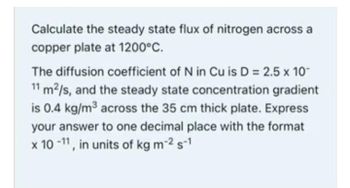Question

Transcribed Image Text:Calculate the steady state flux of nitrogen across a
copper plate at 1200°C.
The diffusion coefficient of N in Cu is D = 2.5 x 10-
11 m²/s, and the steady state concentration gradient
is 0.4 kg/m³ across the 35 cm thick plate. Express
your answer to one decimal place with the format
x 10-11, in units of kg m-2 s-1
Expert Solution
This question has been solved!
Explore an expertly crafted, step-by-step solution for a thorough understanding of key concepts.
Step by stepSolved in 2 steps

Knowledge Booster
Similar questions
- At what height is the atmospheric pressure 29.0% of what it is at sea level? Assume the molar mass of the air molecules to be 29.0 g/mol and that the air temperature is uniformly 287 K. [Answer in kilometres with 3 sig digits, but do not enter units with your answer]arrow_forwardWe know from Newton's Law of Cooling that the rate at which an object warms up is proportional to the difference between the ambient temperature of the room and the temperature of the object. The differential equation corresponding to this situation is given by y' = k(M – y) where k is a positive constant. The solution to this equation is given by y = M + (yo – M)e-kt , where yo is the initial temperature of the object. Suppose your Thanksgiving turkey is kept at a temperature of 40 degrees Fahrenheit until it is put into a 350 degree Fahrenheit oven. It takes 2 hours for the turkey to warm up to a safe eating temperature of 165 degrees Fahrenheit. Find the values of yo, M, and k, for this situation, rounding your answers to 3 decimal places. Yo= M = k= Regardless of your answers above, suppose the k value in this situation is k = 0.3. Find the initial rate of increase of the turkey's temperature as soon as it is placed in the oven. Round to 3 decimal places. degrees per hour.arrow_forwardViscosity of fluid plays a significant role in the analyses of many fluid dynamics problems. The viscosity of water can be determined from the following correlation: q10(72,) where e = viscosity (N/s•m²) T- temperature (K) - 2.414 x 10-s 2 - 247.8 (K) s = 14 0 (K) What is the appropriate unit for q, if the above equa- tion is to be homnogeneous in units?arrow_forward
- A sealed 19 m3 tank is filled with 7,011 moles of ideal oxygen gas (diatomic) at an initial temperature of 292 K The gas is heated to a final temperature of 490 K. The atomic mass of oxygen is 16.0 g/mol. The final pressure of the gas, in MPa, is closest to: answer round to 4 sig.figarrow_forwardWhat is the RMS speed of Helium atoms when the temperature of the Helium gas is 312.0 K? (Possibly useful 1.66x10-27 kg, Boltzmann's constants: the atomic mass of Helium is 4.00 AMU, the Atomic Mass Unit is: 1 AMU constant is: kg = 1.38×10-23 J/K.) kB Submit Answer Tries 0/12 What would be the RMS speed, if the temperature of the Helium gas was doubled? Submit Answer Tries 0/12 =arrow_forwardVRMS-1 Consider a container of Argon gas at a temperature of 25.0 °C. The mass of an Argon atom is 39.96 AMU, where 1 AMU = 1.66×10-27 kg. (a) What is the average kinetic energy per Argon atom, in Joules (J)? (b) What is the RMS average speed of the Argon atoms, in meters per second (m/s)? (c) What would the temperature of the gas have to be for the RMS average speed to 275 m/s? Give your answer in degrees Celsius (°C).arrow_forward
- In a gas that is a mixture of water (two H and one O) and carbon dioxide (one C and two O), if the water has average velocity of 347 m/s, what is the average velocity of the carbon dioxide molecule? Give your answer as number in units of m/s without entering the units.arrow_forwardA balloon is filled with helium gas at atmospheric pressure (1 atm) until its volume is 800 m³. The helium gas is then transferred to cylinders that have a volume of 2.3 m³ at a pres- sure of 13.3 atm. Calculate the number of cylinders used. Assume that the temperature of the helium gas remains constant. (1 atm = 1.013 × 105 Pa).arrow_forwardProblem 3. The viral coefficients of a gas at 20 °C and 11.5 bar are B = -138 cm³ mol¹ and C=7222 cmº mol². Calculate the V (molar volume) Z (compressibility factor) of the gas. Use the equation below (R = 83.14 cm³ bar mol-¹ K-¹). PV 2 = ² = (1 + = + =) Z RTarrow_forward
- A 6.00-m-long cylinder of solid aluminum has a radius of 3.00 cm. "If the cylinder is initially at a temperature of 7.00 C, how much will the length change when the temperature rises to 40.0°C? (Express your answer to three significant figures.) Submit m Due to the temperature increase, by how much (in %) would the density of the aluminum cylinder decrease? (Express your answer to three significant figures.) Submit % By what percentage does the volume of the cylinder increase? (Express your answer to three significant figures.) %arrow_forwardWhen the coefficient of linear expansion, a, and the temperature change, T-T, are large, a length L, of a solid substance expands in length to a(T, -T₂) L₁ = L₁e O L=L[1 + a(Tƒ– T;)]. ○ Ly=al (Ty-T). O L=L[1 + In(a(T₁-T))]. a(T, I₂ = ₁₂₁[ 1 + ª²(²₁-7)].arrow_forward
arrow_back_ios
arrow_forward_ios